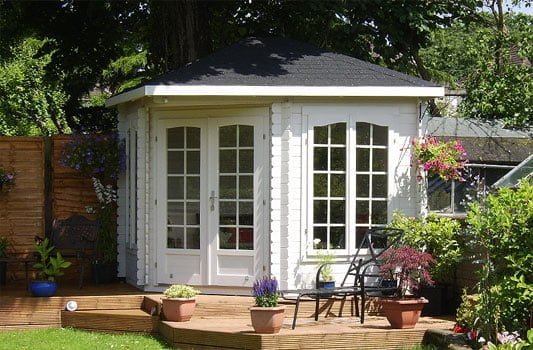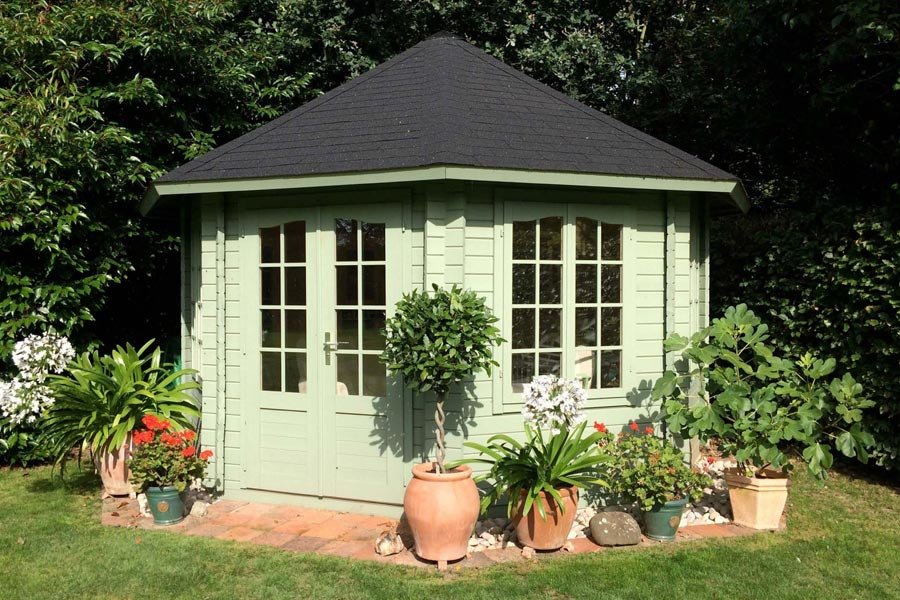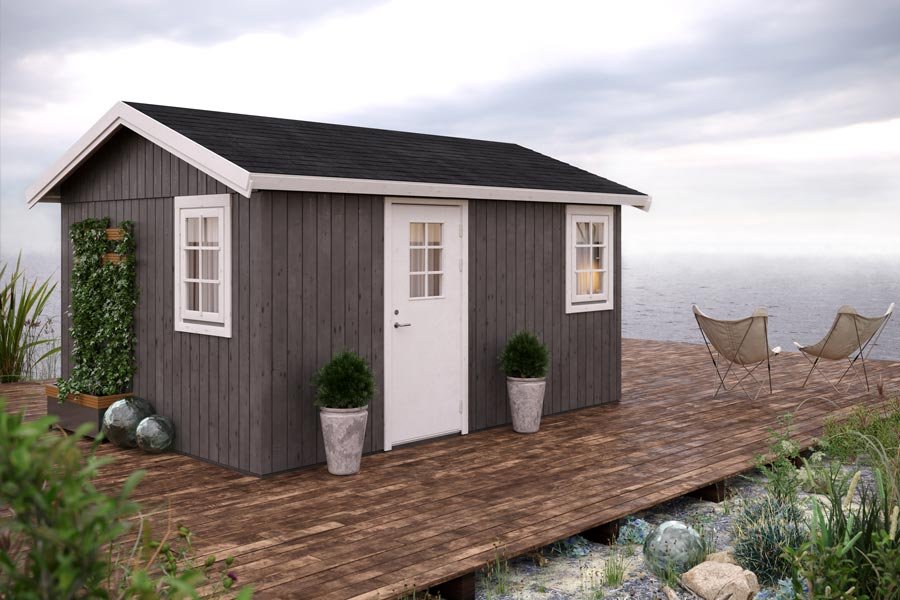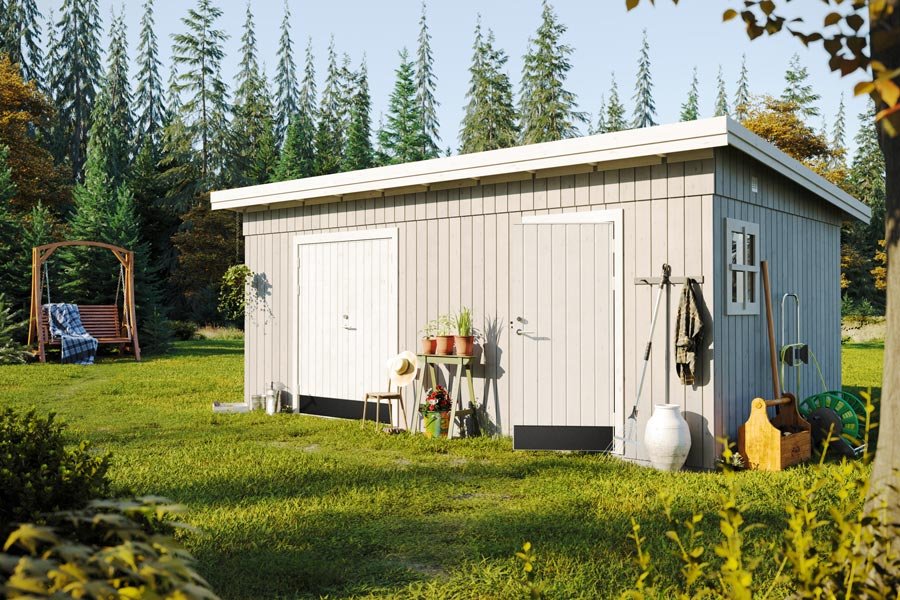Conservatory versus summer house? Here’s our quick run down of the pros and cons followed by some detailed and important pointers:
Pros & Cons | Conservatory | Summer house |
| Self install available? | No | Yes |
| Planning permission required? | Possibly, check local laws | Possibly, but not normally if the roof height is under 2.5m |
| Cost per square foot? | High, on average £200 per sqr foot | Low, £20 – £50 per sqr foot |
| Location options? | Fixed to the house | Anywhere in the garden |
| Direction faced? | South | Any direction |
| Added house value? | Yes | Yes |
| Sustainability options? | Timber models only | Yes |
| Maintenance required? | Occasional cleaning with occasional timber treatment on wood framed models | Occasional timber treatment |
1. What’s the difference between a conservatory, sunroom and summer house?

Conservatories are generally glass (or polycarbonate) rooms attached to a house. A key detail is that the roof is made from glass/polycarbonate, meaning that the sun shines straight into the room. Conservatories can come in different styles, from simple lean-to affairs to large bespoke orangeries. ConservatoryDesigns.co.uk has a good guide to different styles, helping you tell your gull wing from your P-shape.
Then there’s a sunroom, also sometimes referred to as a sun lounge or a garden room. This is also attached to the house, but has a solid roof, offering more protection from overhead sun and heat loss.
And then there are summer houses, and other garden buildings, such as garden offices. These may also be referred to as garden rooms, and can range from a simple timber pavilion to a fully-insulated multi-roomed home office.
2. The pros and the cons of a conservatory

The great benefit of a conservatory or sunroom is that you don’t have to leave the house to get there. Good news during showery weather. And because they are attached to the house, they minimize the space you have to give up in the garden.
However, both conservatories and sunrooms come with less desirable baggage. The anti-conservatory lobby say that a south-facing conservatory is too hot to step into for half the year. But a north-facing version, whilst perfect in summer, may feel Arctic in winter. The pro-conservatory lobby will say blinds and ventilation can tackle the former problems, and insulation and heating the latter. True enough, but these measures can add to the expense, sometimes considerably.
You are also limited in how you position the conservatory, especially if you live in a terraced home or have limited space at the side of the house. If the back of your house faces south, then so must your sunroom.
Lastly, many people find that in adding a conservatory, they ‘lose’ the room it is attached to. A room previously used as a dining or sitting room or a study may now seem more like a corridor on the way to the garden room. These are the main pros and the cons of a conservatory, however good design can mitigate against some of them (but this might require a more expensive bespoke solution).
3. Summer houses – the best alternative to a conservatory?
In contrast to conservatories, summer houses and garden rooms can be oriented any way you wish: for example, a sun room at the bottom of a south-facing garden could have the main doors and windows facing north. And corner summerhouses can be just as space-efficient in a small garden as a conservatory.
And if the 180-degree garden views available in a conservatory attached to the back of a house are insufficient for you, there are summer houses with 360-degree views (which simply can’t be replicated with a conservatory).
Secondly, free standing timber summer houses can offer more space for possessions as well as people. You could devote a corner of your new conservatory to lawnmowers, tools and bikes, but let’s just say the aesthetic appeal might be diminished. Of course, this would apply equally with a beautiful new summer house – hence the appeal of a garden room with a separate secure storage area (so you can keep your messy garden tools separate to your living space).
Ultimately, if you really like the idea of a sunroom extension but the cost and limited floor space is putting you off, a summer house is probably the best alternative to a conservatory.
4. Conservatory versus summer house – the questions to ask
There’s no right answer to the conservatory versus summer house debate. But whatever you buy, the important thing is to choose a style that will be spacious enough, warm enough, cool enough, robust enough, and loved enough by you and your family.
Here are some points to look for when trying to ensure those things:
- Look at the quality of materials used – for example, thicker, denser timber offers greater insulation, as do double-glazed windows.
- Think about ventilation – are there enough doors and windows to let in air if you want it, and are there tilt-turn windows to add flexibility?
- What flooring, insulation and security options are available?
- Think about how much of your garden will be taken up by the structure and mark out the area to understand the impact on the garden. Will it be too small or too big?
- Following on from the above, consider the overall internal floor space (which will be smaller than the building footprint). Will the conservatory or summer house be large enough to accommodate your furniture or hobbies? Again, marking out actual sizes on the ground can help.
If you’re inclined towards the conservatory route, there’s a good buying guide on the Telegraph website. And if you want to know what to look for when buying a summer house check out our buyer’s guide to timber garden buildings.
5. The practical part: price and planning permission
How much a conservatory or summer house costs is a difficult one because of the vast range of styles, sizes and designs. A common answer with conservatories is from £5,000 to £30,000, but with bespoke versions the upper limit will be higher. And the design details that make a conservatory practical and liveable – from double-glazing, to ventilation and underfloor heating can bring up the price considerably. Ultimately, adding a conservatory is the most expensive form of extension costing around £200 per sq foot.
With garden rooms, there is also a wide range of prices, depending on the spec chosen – from summer-only pavilion to year-round business HQ or accommodation – but it is usually easier to tell in advance how much the costs are because they are all-inclusive (including the building itself, roofing materials, accessories, delivery and installation, if required). They should also offer a much lower starting price – there are good quality summer houses starting from £1000 and well built summer houses should only cost £20 – £50 per sq foot (including ground work, foundations, roofing and installation, if required).
Finally, there is the issue of whether planning permission is required. With both conservatories and garden buildings, the answer is maybe. It will depend on their size, height, distance from the boundaries of your property, whether they contain sleeping accommodation, and so on. The rules differ slightly in England and Scotland, and also in certain conservation areas. Best thing is to check with your local council or check our guide to planning permission for summer houses.
Lastly, if you’re installing a conservatory or summer house to help add value to your home, remember it will only make your home more desirable and saleable if it is of high quality and well maintained (no one wants to buy a house with a damp draughty conservatory or dilapidated summer house that’s full of junk).


















